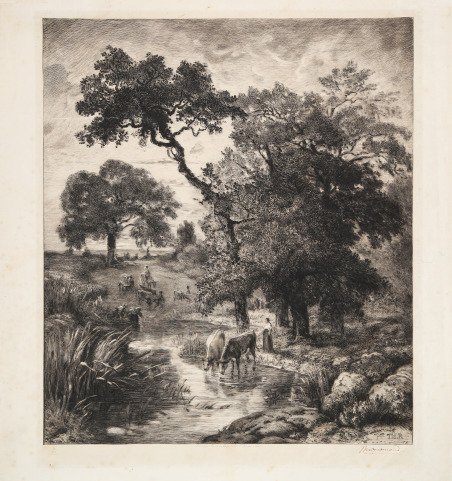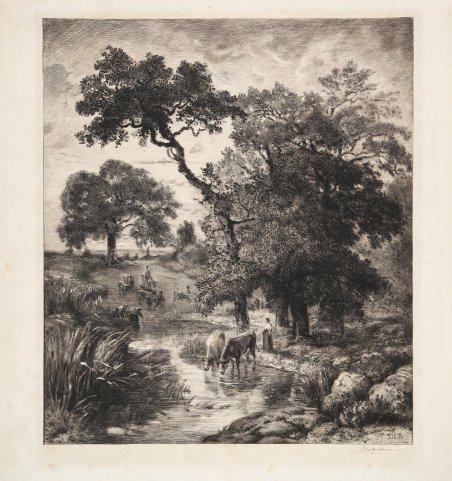Acquaforte e puntasecca, 1882, da un soggetto di Théodore Rousseau. Impressione con firma autografa di Bracquemond; in basso a destra, timbro a secco della Printseller Association. Magnifica prova, del sesto stato su sei descritto da Beraldi, impressa su carta Cina, in eccellente stato di conservazione. Il dipinto di Rousseau da cui proviene l'acquaforte è Coucher de soleil : ou, Un abreuvoir ( ca. 1850-55 ), che è apparso all'asta da Sotheby's . New York, 17 febbraio 1993, lotto n. 12, intitolato Coucher de soleil dans les landes prés de Begaar e che oggi si trova in una collezione privata. Il quadro di Rousseau fu il primo dipinto dell'importante maestro acquistato dalla neonata galleria Arnold & Tripp, che aveva aperto nel gennaio 1881: fu acquistato da Georges Petit, esperto di Vente Hartmanna, per 20.000 franchi il 16 maggio 1881, e venduto il giorno seguente per 26.000 franchi al collezionista portoghese Pedro Eugenio Daupias. Arnold & Tripp, dopo aver acquistato e subito venduto il quadro Coucher de soleil, decisero di chiedere a Bracquemond di realizzare una lastra da cui ricavare delle copie da vendere. Questo indica che la galleria aveva mantenuto i diritti di riproduzione del dipinto, o almeno aveva un accordo con il proprietario in tal senso. L'identificazione del quadro da cui proviene l'acquaforte è quindi particolarmente interessante perché Bracquemond non fu incaricato di produrre un'incisione per promuovere la vendita del quadro, che la galleria aveva già venduto a Daupias nel maggio 1881. Piuttosto, come era comune con le incisioni, si rivolgeva al suo particolare mercato di collezionisti, sicuramente interessati ad avere un'incisione da un dipinto che era diventato parte di una famosa collezione di Lisbona, e che non avrebbero più potuto ammirare a Parigi. La scoperta del contratto stipulato tra la galleria parigina Arnold & Tripp e il pittore e incisore Felix Bracquemond è un fatto recente. Il contratto fa parte di un gruppo di sette lettere, contenute nel carteggio Arnold & Tripp, che illustrano tutti gli aspetti dell'affare, dal contratto formale del luglio 1881, alle varie fasi delle prove, fino alla lastra finale da presentare al Salone parigino del 1882. Per un’approfondimento sul tema, si rimanda al saggio di Paolo Serafini, An Inside View of the Print Market in Paris (1881) A Contract between Félix Bracquemond and the Arnold & Tripp Gallery to Realize a Plate after Théodore Rousseau, in “Getty Research Journal”, n. 10 (2018), pp. 207-224). Già nel contratto Bracquemond fa riferimento a sei stati della lastra, poi descritti da Henri Beraldi (cfr. Les Graveurs du XIXe siècle s…, t. 3, pp. 109-110). Etching and drypoint, 1882, inscribed beneath the image lower left B lower Publie par Arnold et Tripp. & Rue St Georges a Paris. In the image, lower right TH. R After a painting by Théodore Rousseau. Example in the sixth finale state, with the signature and the publisher’s address lower centre. Etched by Félix Bracquemond (1833–1914). Impression signed by Bracquemond, in pencil. Printsellers' Association's blind stamp at lower left. The painting from which the etching comes is Coucher de soleil : ou, Un abreuvoir ( ca. 1850-55 ), which appeared at auction at Sotheby's . New York , 17 February 1993 , lot no . 12 , titled Coucher de soleil dans les landes prés de Begaar and which today is held in a private collection. ' The Rousseau painting was the first painting by the important master purchased by the newborn gallery Arnold & Tripp gallery, which had opened in January 1881. The painting was bought from Georges Petit for 20,000 francs od 16 May 1881, and sold the following day for 26,000 francs to the Portuguese collector Pedro Eugenio Daupias. Arnold & Tripp, after having purchased and ' immediately sold the painting Coucher de soleil , decided to ask Bracquemond to produce a plate from which to derive copies to sell . This indicates that Arnold & Tripp had retained the reproduction rights for the painting , or at least had an agreement with the owner to that effect. The identification of the painting from which the etching comes is therefore particularly interesting because Bracquemond was not contracted to produce an engraving in order to promote the sale of the painting, which the gallery had already sold to Daupias in May 1881. Rather, as was common with artists' etchings, it was aimed at its own particular market of collector, surely interesting in having an engraving of a painting that had become part of a famous collection in Lisbon, and which they would no longer be able to admire in Paris. Recently, in the archives of the Getty Research Institute was discovered a contract between the Parisian gallery Arnold & Tripp and the painter and etcher Felix Bracquemond (1833-1914) in order to realize a plate after a painting by Théodore Rousseau. The contract is part of a group of seven letters, contained in the Arnold & Tripp correspondance, that illustrate all the aspects of the deal, from the formal contract in July 1881 , to the various phases of the proofs, toward the final plate to be presented at the Parisian Salon of 1882. (cfr. Paolo Serafini, An Inside View of the Print Market in Paris (1881) A Contract between Félix Bracquemond and the Arnold & Tripp Gallery to Realize a Plate after Théodore Rousseau, in Getty Research Journal, n. 10 (2018), pp. 207-224). Cfr. H. Beraldi, tome 3, pp. 109 - 110; Paolo Serafini, An Inside View of the Print Market in Paris (1881) A Contract between Félix Bracquemond and the Arnold & Tripp Gallery to Realize a Plate after Théodore Rousseau, in “Getty Research Journal”, n. 10 (2018)


Scopri come utilizzare
Scopri come utilizzare

